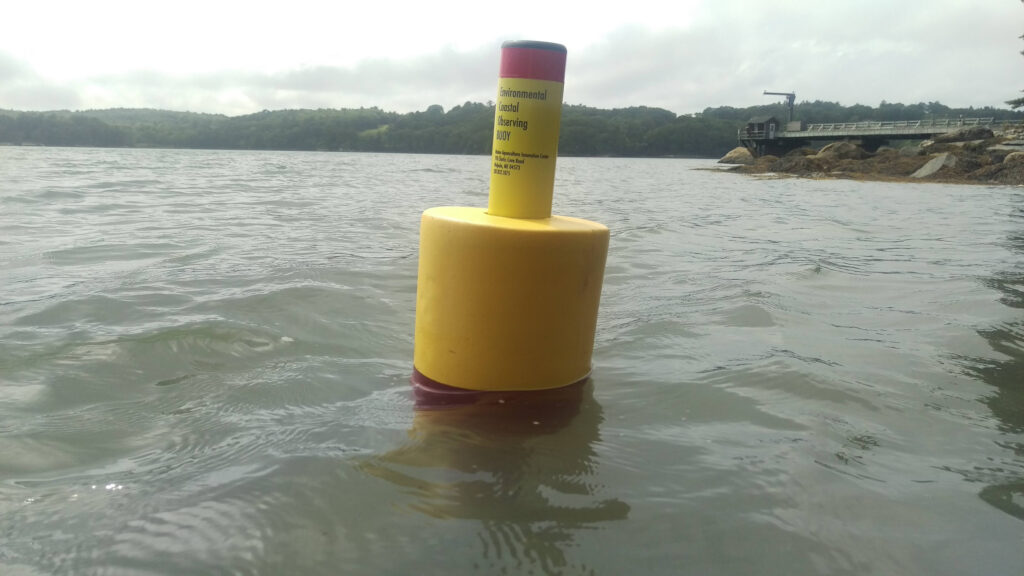
Research-industry partnership creates novel low-cost environmental monitoring buoy
When University of Maine alum Joshua Girgis graduated from University of Maine’s College of Engineering in 2018, he never imagined where he would end up next. This Madison, Maine native had enjoyed his four years in Orono and was looking to put his newly minted engineering skills to the test.
“I was ready for a challenge, and to connect what I’d learned in classes to real-world problems,” Joshua recalls. Late spring 2018, he responded to an internship posting from Chris Davis, Director of the Maine Aquaculture Innovation Center. Dr. Davis was seeking an engineering student to join him at MAIC, which is co-located at UMaine’s Darling Marine Center in Walpole.
Joshua arrived at the University’s marine laboratory along with the other 30 interns in summer 2018, met Dr. Davis and got to work. The goal was clear but distant: build an affordable environmental monitoring buoy that oyster and seaweed farmers could use to track conditions on their farms. Such a buoy would enable these small business owners to have real-time water quality information about where to site their farms and when to put seed oysters and kelp in the water. This buoy, designed to gather information on ocean temperature, salinity, and productivity, also gives fishermen, resource managers and citizen scientists a new way of gathering fine-scale information about the coastal environment.
Joshua labored away in the Marine Culture Laboratory at the Darling Marine Center all summer, prodding at circuit boards and poring over technical specifications written in 6-point font. He also enjoyed life on the coast. “The Darling Center in the summer is really special. People come from all over to conduct research and learn,” Girgis observed. When fall came, he wasn’t ready to leave, he’d made great progress developing the buoy prototype, but it wasn’t ready for the river yet.
During a meeting of aquaculture-related researchers and students at the DMC, Davis shared an update on Joshua’s progress. “To get something in the water, that people will be able to purchase and use, we need more expertise and more time,” he reported.
After several more brainstorms, a bigger team developed, including UMaine Marine Sciences and Engineering faculty, as well as Girgis and Davis. With support from UMaine’s commercialization program as well as a number of colleagues throughout the state, they were able to push ahead with the design and develop a watertight buoy, ready for field testing.

In the last 12 months, Girgis led the team’s effort to reduce the cost of the buoy and make it easier to assemble it, using a mix of commercially available and custom-manufactured parts. He also developed the data interface between the buoy and a website that enables farmers to check to see conditions where the buoy is in the water. At this point, the price per buoy is just over $2000, with a monthly operating fee of $7.
With the arrival of COVID-19, Girgis’ work has shifted again. He’s working remotely from his family home in Madison and doing what he can to improve the design of the sensors and further lower the price per buoy.
“I’m looking forward to getting back to Walpole when we can safely work onsite again. I’m eager to field test these newest improvements,” Girgis says.
“In the meantime, I’m also thinking about where to go next with my education. This project has given me a solid baseline to continue learning,” Girgis reflects. “I learned many mechanical and electronics engineering skills and now have the ability to design devices that not only survive but work in the marine environment. That feels good!”
Contact: Joshua Girgis, joshua.girgis@maine.edu and Heather Leslie heather.leslie@maine.edu
This project was supported by the University of Maine System Research Reinvestment Fund, Maine Aquaculture Innovation Center, Maine Technology Institute, Maine ESPCoR and the US National Science Foundation, and the University of Maine Darling Marine Center.
Founded in 1965, the Darling Marine Center’s mission is to connect people to the ocean. The center’s researchers, staff and students work alongside fishermen, aquaculture entrepreneurs, marine industry professionals and other members of the community in Maine and around the world. More information is available at dmc.umaine.edu
